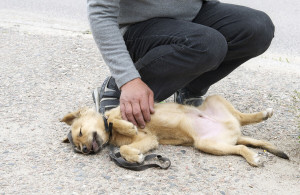

This program will be regularly monitored by the NSW National Parks and Wildlife Services as part of their risk management.
The poison used is 1080 (sodium fluoroacetate), and is packaged as pre-made baits (rather than fresh meat baits), and buried.
1080 is extremely toxic, and dogs (and cats) are at risk if they:
- Dig up and eat the bait
- Eat vomit containing the poison
- Eat dead, poisoned animals
The best protection for your dog is not to let them roam or run free in and around the areas where baits are. If you do walk your dog in this area, then do so on a lead. If your dog is prone to scavenging, consider a basket muzzle as a quick swallow of poisonous vomit in a bush, not noticed by the owner can be fatal.
Symptoms can occur within half an hour to 6 hours or longer after ingestion of the poison with early symptoms to look out for include:
- vomiting
- uncontrolled urination and defecation
- sensitivity to sound and light
- disorientation and shaking
The symptoms progress to frenzied behaviour such as running, screaming/howling, drooling, seizures, breathing problems, and finally total collapse and death.
There is no specific antidote for 1080. Therefore, it is crucial to get your dog to the nearest vet as soon as possible. Ring ahead so the vet team can prepare for your arrival.
Making your dog vomit at home is possible, but not always without risk, taking your dog to the vet without delay is preferred action.
If you can’t get to a vet or there is a delay in getting to the vet, there are household products that may help to induce vomiting, this is not without risks and should only be attempted in the early stages of the poisoning.
Placing a few crystals of washing soda, or a teaspoon of salt on the back of the tongue can induce vomiting. However, too much salt or washing soda can make your pet ill as well. Of a greater concern your dog may react too violently to the vomiting or may inhale the vomit, causing inhalation pneumonia.
You may also be unsuccessful in making your pet vomit.
If you are successful, remove the vomit immediately to minimise the risk of another pet ingesting it and make sure you are wearing gloves. Dispose of the vomit carefully, and make sure to seek veterinary attention immediately afterwards, as continuing supportive care is still of the utmost importance.
For further information or any other concerns you may wish to discuss, please contact Cronulla Vet Clinic’s friendly staff on 02 9527 2604.
